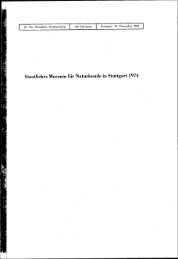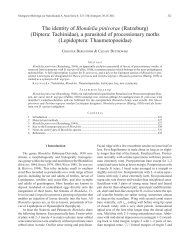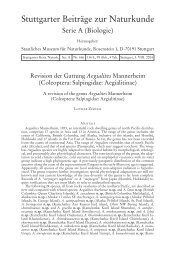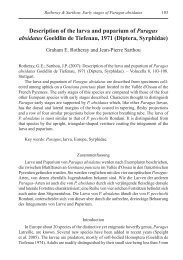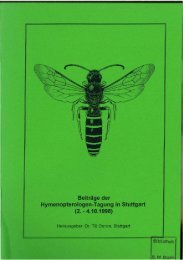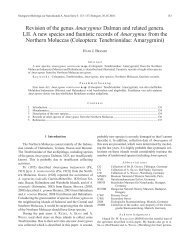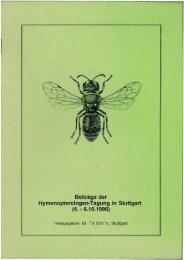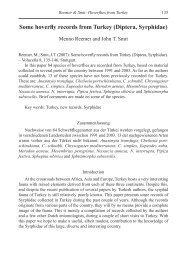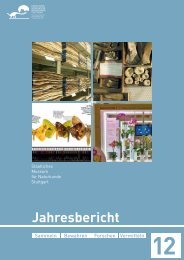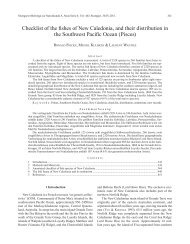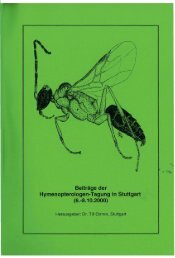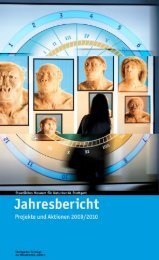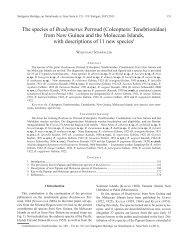Serie A (Biologie) - Staatliches Museum für Naturkunde Stuttgart
Serie A (Biologie) - Staatliches Museum für Naturkunde Stuttgart
Serie A (Biologie) - Staatliches Museum für Naturkunde Stuttgart
Create successful ePaper yourself
Turn your PDF publications into a flip-book with our unique Google optimized e-Paper software.
60 stuttgarter beiträge zur naturkunde Ser. A, Nr. 69411 Lateral margin of pronotum distinctly sinuated before posterior angles (Fig. 5). – Sri Lanka. . . . . . . . . . . . . . . . . . . . . . . . . . . . . . . . . . . . . . . . . . . . . . . . . . . . . . . . . . . . . . . . B. aeratus– Lateral margin of pronotum not sinuated before posterior angles (Fig. 28). Aedeagus as inFig. 93. – Philippines . . . . . . . . . . . . . . . . . . . . . . . . . . . . . . . . . . . . . . . . . . . . B. eschscholtzi12 Last 3 antennomeres forming a club; elytral intervals slightly convex; anterior corners ofpronotum not protruding (Fig. 4) . . . . . . . . . . . . . . . . . . . . . . . . . . . . . . . . . . . . . . B. aeneus– Last 4 antennomeres forming a club; elytral intervals flat; anterior corners of pronotumprotruding (Fig. 63). Aedeagus as in Fig. 127 . . . . . . . . . . . . . . . . . . . . . . B. reibnitzi n. sp.13 Anterior tibia in males with 1–2 distinct teeth at the inner side (as in Fig. 31) . . . . . . . . 14– Anterior tibia in males without any armature . . . . . . . . . . . . . . . . . . . . . . . . . . . . . . . . . . 2414 Anterior tibia in males with a pair of distinct teeth at the inner side (Fig. 31). Aedeagus asin Fig. 97 . . . . . . . . . . . . . . . . . . . . . . . . . . . . . . . . . . . . . . . . . . . . . . . . . . . . . B. fouquei n. sp.– Anterior tibia in males with a single tooth at the inner side . . . . . . . . . . . . . . . . . . . . . . . 1515 Tooth in the middle of the male tibia . . . . . . . . . . . . . . . . . . . . . . . . . . . . . . . . . . . . . . . . . 16– Tooth in the anterior third of the male tibia . . . . . . . . . . . . . . . . . . . . . . . . . . . . . . . . . . . . 1716 Body length 9.0 mm; pronotum longer; alternate elytral intervals 3, 5, 7 without distinctkeels and with feeble pore-bearing granules (Fig. 22). Aedeagus as in Fig. 88 . . . . . . . . . . .. . . . . . . . . . . . . . . . . . . . . . . . . . . . . . . . . . . . . . . . . . . . . . . . . . . . . . . . . B. crockerensis n. sp.– Body length 6.5–7.2 mm; pronotum wider; all elytral intervals with a row of distinct porebearinggranules (Fig. 35). Aedeagus as in Fig. 101 . . . . . . . . . . . . . . . . . . . B. grimmi n. sp.17 Last 3 antennomeres forming a club; antennae extraordinary long (Fig. 45). Aedeagus as inFig. 110 . . . . . . . . . . . . . . . . . . . . . . . . . . . . . . . . . . . . . . . . . . . . . . . . . . . B. kinabalicus n. sp.– Last 4 antennomeres forming a club; antennae of normal length . . . . . . . . . . . . . . . . . . . 1818 Dorsal side dull blackish . . . . . . . . . . . . . . . . . . . . . . . . . . . . . . . . . . . . . . . . . . . . . . . . . . . 19– Dorsal side shining blackish, brownish or ferrugineous . . . . . . . . . . . . . . . . . . . . . . . . . . 2019 Anterior corners of pronotum protruding; only alternate elytral intervals 5, 7 with keels;punctures of the elytral rows deeply impressed, longitudinal (Fig. 58). Aedeagus as inFig. 121 . . . . . . . . . . . . . . . . . . . . . . . . . . . . . . . . . . . . . . . . . . . . . . . . . . . . . . . B. merkli n. sp.– Anterior corners of pronotum not protruding; alternate elytral intervals 3, 5, 7 with keels;punctures of the elytral rows normally impressed, round (Fig. 49). Aedeagus as inFig. 115 . . . . . . . . . . . . . . . . . . . . . . . . . . . . . . . . . . . . . . . . . . . . . . . . . . . . . . B. laoticus n. sp.20 All elytral intervals slightly convex and without any keels or granules (Fig. 10). Aedeagusas in Fig. 83 . . . . . . . . . . . . . . . . . . . . . . . . . . . . . . . . . . . . . . . . . . . . . . . . . . . . . . B. atronitens– At least some elytral intervals with keels or granules . . . . . . . . . . . . . . . . . . . . . . . . . . . . 2121 Pronotal disc with rough and confluent punctation, between punctures with distinctgranules (Fig. 29). Aedeagus as in Fig. 96 . . . . . . . . . . . . . . . . . . . . . . . . . . . . . . B. fukiensis– Pronotal disc with dense or even confluent punctation, but without granules . . . . . . . . 2222 Alternate elytral intervals 3 (interrupted in the middle), 5, 7 with keels; keels with distinctgranules, intervals 1, 2, 4, 6 with a row of distinct granules (Fig. 36). Aedeagus as inFig. 102 . . . . . . . . . . . . . . . . . . . . . . . . . . . . . . . . . . . . . . . . . . . . . . . . . . . . . . B. hauseri n. sp.– Elytral structure different . . . . . . . . . . . . . . . . . . . . . . . . . . . . . . . . . . . . . . . . . . . . . . . . . . . 2323 All elytral intervals convex, interval 7 somewhat higher and with a row of fine pore-bearinggranules (Fig. 67). Aedeagus as in Fig. 130 . . . . . . . . . . . . . . . . . . . . . . . . . . . B. sijthoffi– Alternate elytral intervals 3, 5 with feeble keels, interval 7 with a more distinct keel, intervals2, 4, 6 slightly convex and without any granules (Fig. 26). Aedeagus as in Fig. 89 . . .. . . . . . . . . . . . . . . . . . . . . . . . . . . . . . . . . . . . . . . . . . . . . . . . . . . . . . . . . . . . . . . . B. drescheri24 Genae narrower than eyes . . . . . . . . . . . . . . . . . . . . . . . . . . . . . . . . . . . . . . . . . . . . . . . . . . 41– Genae distinctly broader than eyes or at least as broad as eyes . . . . . . . . . . . . . . . . . . . . 2525 All elytral intervals with identical fine keels . . . . . . . . . . . . . . . . . . . . . . . . . . . . . . . . . . . . 26– Only alternate elytral intervals with keels or intervals partly with granules instead ofkeels, or without keels but with rows of granules . . . . . . . . . . . . . . . . . . . . . . . . . . . . . . . 2726 Pronotal disc with confluent punctation, between punctures without granules; tibiae externallywith fine keels. Habitus as in Fig. 68. Aedeagus as in Fig. 131 . . . . . . . . B. spretus– Pronotal disc with dense punctation, between punctures with fine granules; tibiae externallywithout keels. Habitus as in Fig. 61. Aedeagus as in Fig. 125 . . . . . . . B. propinquus27 Alternate elytral intervals 3, 5, 7 with distinct, complete and identical keels, other intervalswith or without rows of granules . . . . . . . . . . . . . . . . . . . . . . . . . . . . . . . . . . . . . . . . . . . . 28– Alternate elytral intervals different, mostly with granules, granules partly confluent . . 36



